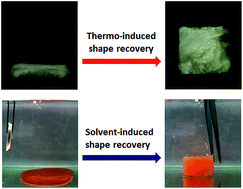Multifunctional shape-memory foams with highly tunable properties via organo-phase cryo-polymerization
Abstract
Polymer foams with interconnected open macropores have been widely utilized in industry and our daily lives. Cryopolymerization is a simple yet efficient method to prepare open porous materials. However, in most cases, this technique was used in an aqueous phase to synthesize macroporous hydrogels; moreover, diversity in these materials needs to be further developed to achieve multi-functionality. In this study, we present organo-phase cryopolymerization as a facile and general method to synthesize acrylate-based shape-memory foams with controllable pore architecture and highly tunable properties including thermomechanical behavior and swelling capability. Pore orientation and porosity can also be controlled through manipulating the conditions of cryopolymerization such as freezing routes and monomer concentrations. By varying the monomer compositions (methyl methacrylate/butyl acrylate), shape-memory foams with a highly tunable transition temperature (Tg from approximately −43 °C to 123 °C) were obtained. Amongst various potential applications, we demonstrated that the shape-memory foams can be programmed into a rather compact form and can expand only during the solvent absorption process to allow simultaneous fast and large absorption, an advantage over the intrinsic bulkiness of classical porous absorbents. Poly(lauryl methacrylate) foam was also prepared, which enabled fast absorption of various solvents including gasoline (ADf = 10.2 g g−1).



 Please wait while we load your content...
Please wait while we load your content...